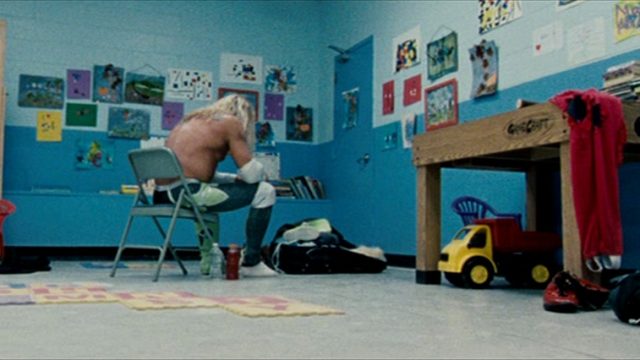To me, one of the most fascinating subgenres of the “dad movie” is what’s known as the “guy cry” movie. These films, like Terminator II and The Shawshank Redemption, somehow find a way to barrel past gender essentialist maxims and society’s ingrained toxic masculinity to create a framework for men to be deeply moved by art. While directors like James Cameron and Frank Darabont have a touchy-feely sensibility that lends itself well to this subgenre, it’s surprising that Darren Aronofsky, the auteur behind mother! and Requiem for a Dream, has made two of them so far: the recently Oscar-nominated The Whale and, more relevant to today’s column, 2008’s The Wrestler.
Aronofsky is one of our few remaining filmmakers who aims to create a masterpiece with every movie. It’s part of his charm, as well as maybe the most enervating aspect of his style — his ambition is inextricably tied to his self-regard and his lack of subtlety. To fans like myself, that’s the fun of his movies. It’s like watching a man play chicken with himself. But after the bomb/masterpiece (bombsterpiece?) of The Fountain, Aronofsky followed up with his most self-consciously small movie to date: an intimate character drama about a self-destructive wrestler, Randy the Ram (Mickey Rourke), whose post-match heart attack leads him to confront his habit of pushing people away.
It’s a tough-tender premise that allows Aronofsky to engage with his favorite theme, how much people will destroy their bodies in pursuit of spiritual satisfaction, while following a premise that just skirts cliché. The movie’s secret weapon is its authenticity: Rourke’s years as a boxer give his performance a blunt physical grace, the cast is rounded out by actual wrestlers, and the meticulous attention to pre-match prep work is fun, while underlining that while the fights may be faked, the pain sure isn’t. (My favorite little touch: Randy was famous enough in the ’80s to have a licensed wrestling game for the NES.)
Unfortunately, the second half of the movie, which sees Randy trying to atone for the sins of his past and find a way forward to future happiness, is less interesting. Bad fathers are a dime a dozen in movies like this, and what exactly drove Randy and his daughter (Evan Rachel Wood) apart is handled with almost no specificity whatsoever. The plot line is almost entirely saved by the incredible work of both Rourke and Wood. The tentative romance between Randy and a stripper, Cassidy (the always-excellent Marisa Tomei), fares better, mostly for the way it allows Aronofsky to comment on what the two professions have in common. It’s telling, however, that the best scenes in the second half of the movie involve Randy at the deli counter of the supermarket where he works during the day (one thing the movie deserves credit for — showing the mental, physical, and spiritual toll of laboring under capitalism, without putting too fine a point on it). Most of the interactions were unscripted, as Rourke served sliced meat and potato salad to actual customers, and his natural charisma shines in these scenes.
Aronofsky found himself in a similar place in 2022 as he did in 2008. He just had a big passion project overwhelmingly rejected by the public, so he went back to a small, intimate character study anchored by a down-and-out star looking for a comeback. Both movies even hinge on a father’s damaged relationship with his daughter. But it seems that Aronofsky has forgotten what has helped The Wrestler become a dad movie staple — it’s easier to forgive a generic plot if the milieu is authentic.
Next time: With Avatar: The Way of Water dominating the box office, we talk about another cool dude named J.C. and some pretty amazing things he did with water…actually it’s the same guy. We’re talking about James Cameron’s The Abyss.

